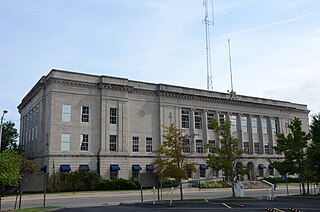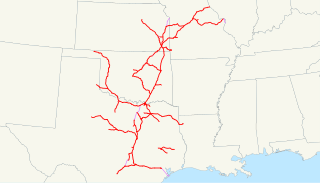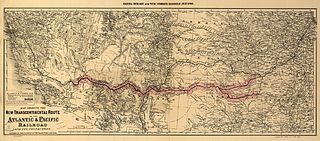Related Research Articles

Muskogee County is a county located in the U.S. state of Oklahoma. As of the 2020 census, the population was 66,339. The county seat is Muskogee. The county and city were named for the Muscogee (Creek) Nation. The official spelling of the name was changed to Muskogee by the post office in 1900.

Muskogee is the thirteenth-largest city in Oklahoma and the county seat of Muskogee County. Home to Bacone College, it lies approximately 48 miles (77 km) southeast of Tulsa. The population of the city was 36,878 as of the 2020 census, a 6.0 percent decrease from 39,223 in 2010.
Barnsdall is a city in Osage County, Oklahoma, United States. The population was 1,034 at the 2020 census, a decline of 21.9 percent from the figure of 1,325 recorded in 2000.
Foraker is a town in Osage County, Oklahoma, United States. It was named for Ohio Senator Joseph B. Foraker. The Tallgrass Prairie Preserve is southeast of town. The official population peaked at 415 in 1910 and has declined steadily since 1930. The population was only 18 at the 2010 census, a 21.7 percent decline from 23 in 2000.

Shidler is a city in Osage County, Oklahoma, United States. The population was 328 in the 2020 census, a decline from the figure of 441 recorded in 2010.
Webb City is an unincorporated town in northwestern Osage County, Oklahoma, United States. The population was 62 at the 2010 census, a 34.7 percent decline from the figure of 95 recorded in 2000. It was named for its founder, Horace Webb, on whose land the town was founded. The Webb City post office opened December 16, 1922.

Wagoner is a city in Wagoner County, Oklahoma, United States. The population was 8,323 at the 2010 census, compared to the figure of 7,669 recorded in 2000. It is the county seat of Wagoner County. Wagoner became the first city incorporated in Indian Territory on January 4, 1896.

The Missouri–Kansas–Texas Railroad was a Class I railroad company in the United States, with its last headquarters in Dallas, Texas. Established in 1865 under the name Union Pacific Railroad (UP), Southern Branch, it came to serve an extensive rail network in Texas, Oklahoma, Kansas, and Missouri. In 1988, it merged with the Missouri Pacific Railroad; today, it is part of UP.
The Midland Valley Railroad (MV) was a railroad company incorporated on June 4, 1903 for the purpose of building a line from Hope, Arkansas, through Muskogee and Tulsa, Oklahoma to Wichita, Kansas. It was backed by C. Jared Ingersoll, a Philadelphia industrialist who owned coal mining properties in Indian Territory. The railroad took its name from Midland, Arkansas, a coal mining town in western Arkansas, which was served by the railroad. The Midland Valley gained access to Fort Smith, Arkansas via trackage rights over the Frisco from Rock Island, Oklahoma.
The Kansas, Oklahoma and Gulf Railway (KO&G) was formed on July 31, 1919 from the assets of the bankrupt Missouri, Oklahoma and Gulf Railway. The KO&G largely consisted of a single line from Baxter Springs, Kansas, to Denison, Texas, prior to its purchase by Missouri Pacific's Texas and Pacific Railway in 1964 and merger in 1970.
The Oklahoma City – Ada – Atoka Railway (OCAA) was formed from trackage from Oklahoma City to Atoka via Shawnee, Ada, and Coalgate, Oklahoma. Atoka to Coalgate had been built between 1882 and 1886 as feeder to the old Missouri–Kansas–Texas Railroad (Katy) main line, and Coalgate-Shawnee-Oklahoma City had been constructed by Katy affiliates, and specifically the first 40 miles northwest out of Coalgate having been built by the Texas and Oklahoma Railroad in 1902. The remaining 78 miles into Oklahoma City were built in the 1903-1904 timeframe by that line’s successor, the Missouri, Kansas and Oklahoma Railroad Company. These properties were not included in the 1923 reorganization of the Katy, and were put in the OCAA instead. The OCAA was sold to the Muskogee Company in 1929, becoming one of the Muskogee Roads.

The Kansas and Oklahoma Railroad is a shortline railroad operating in the Midwestern United States. It is entirely located in Kansas and, despite its name, owns no trackage in Oklahoma.

The Atlantic and Pacific Railroad was a U.S. railroad that owned or operated two disjointed segments, one connecting St. Louis, Missouri with Tulsa, Oklahoma, and the other connecting Albuquerque, New Mexico with Needles in Southern California. It was incorporated by the U.S. Congress in 1866 as a transcontinental railroad connecting Springfield, Missouri and Van Buren, Arkansas with California. The central portion was never constructed, and the two halves later became parts of the St. Louis-San Francisco Railway and Atchison, Topeka and Santa Fe Railway systems, now both merged into the BNSF Railway.

The Central Kansas Railway (CKR) was a short-line railroad operating 900 miles (1,400 km) of trackage in the U.S. state of Kansas and west to Scott City, Kansas. All trackage was former Atchison, Topeka & Santa Fe Railway branchlines in Kansas and northern Oklahoma. The Kansas Southwestern Railway, a sister company which operated former Missouri Pacific Railroad branchlines in Kansas, was merged into the CKR in 2000. Owned by Omnitrax, CKR's main business was from the Kansas wheat harvests, as well as other traffic.

South Kansas and Oklahoma Railroad is a short line railroad which operates 511 miles (822 km) of rail lines in Kansas, Oklahoma and Missouri that used to belong to Missouri Pacific, Frisco and Santa Fe lines. SKOL is a unit of Watco. The present railroad was created in July 2000, when Watco merged one short line railroad, the Southeast Kansas Railroad (SEKR), with another short line, the South Kansas and Oklahoma Railroad. SKOL was the surviving company.
The Muskogee Company, although a Philadelphia company, was founded in Delaware on February 27, 1923. The company officers were brothers C. Jared Ingersoll, industrialist, as president, and John H. W. Ingersoll, attorney and industrialist, as vice president and treasurer. The Muskogee Company owned large interests in several railroads in and about northeastern Oklahoma.
The Muskogee Roads was the colloquial name for a system of railroads under common management operationally headquartered in Muskogee, Oklahoma and controlled by the Muskogee Company of Philadelphia. The Muskogee Roads were the only Class I railroads to be headquartered in Oklahoma and had a major impact on the development and livelihood of the region.
Lyman was a town in Osage County, Oklahoma, located about 20 miles northeast of Ponca City, Oklahoma, and 30 miles southeast of Winfield, Kansas, the two closest population centers. It became an oilfield boomtown shortly after the discovery of the Burbank field in 1920. It was named after A.J. Lyman, who platted the town and sold the lots.
The Muskogee Electric Traction Company (“Traction”) was an electrified streetcar line operating in and around Muskogee, Oklahoma from 1904 to 1941, with bus passenger service continuing under that name to 1958.
The Muskogee Southern Railroad, which existed from 1902 to 1904, constructed only one line in its history. It built south from Muskogee, Oklahoma to the Canadian River, a distance of approximately 37 miles.
References
- 1 2 3 "Muskogee Company records, Part 1". The University of Texas at Austin, University of Texas Libraries. Retrieved October 25, 2021.
- 1 2 "Foraker". Jon D. May, Oklahoma Historical Society. Retrieved October 26, 2021.
- ↑ "Shidler". Jon D. May, Oklahoma Historical Society. Retrieved October 26, 2021.
- ↑ "Webb City". Jon D. May, Oklahoma Historical Society. Retrieved October 26, 2021.
- ↑ "Osage County, Oklahoma-Lyman". Geocaching. Retrieved October 26, 2021.
- ↑ "History of the Osage". Sharon Hamilton, USGenWebArchives. Retrieved October 26, 2021.
- 1 2 3 "Osage Railroad 1000 leads a South Kansas & Oklahoma Railroad train in the Moline, KS yard in July 1991". Watco, July 19, 2018 (accessed on Facebook). Retrieved October 26, 2021.
- 1 2 "Old rails may become trail". Curtis Killman, Tulsa World, December 28, 2000. 28 December 2000. Retrieved October 26, 2021.
- ↑ "Midland Valley Railroad". Augustus J. Veenendaal, Jr., Oklahoma Historical Society. Retrieved October 26, 2021.
- ↑ "Missouri Pacific Railway". Augustus J. Veenendaal, Jr., Oklahoma Historical Society. Retrieved October 26, 2021.
- ↑ "Oklahoma 1989 Official State Railroad Map". Oklahoma Department of Transportation. 3 December 2009. Retrieved October 26, 2021.
- ↑ "Osage Prairie Trail". Landplan Consultants. Retrieved October 26, 2021.